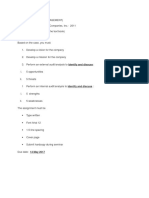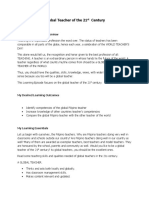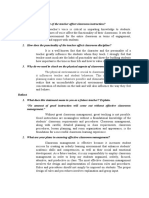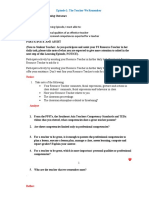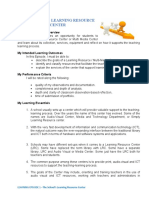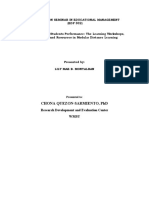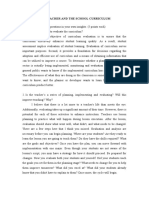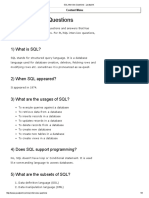CHAPter 5
CHAPter 5
Uploaded by
Sharreah LimCopyright:
Available Formats
CHAPter 5
CHAPter 5
Uploaded by
Sharreah LimOriginal Description:
Copyright
Available Formats
Share this document
Did you find this document useful?
Is this content inappropriate?
Copyright:
Available Formats
CHAPter 5
CHAPter 5
Uploaded by
Sharreah LimCopyright:
Available Formats
CHAPTER V
CONCLUSIONS AND RECOMMENDATIONS
This chapter presents the conclusions, and the prescribed recommendations of
the study
Conclusions
Based on the results of the study, the following conclusions were formulated. The
teachers of Kiamba I District were rated High on their level of preparation in distance
learning education. It was evident and backed up by the answers of the teachers from
the open ended questions. The overall result of the study suggests that the teachers
were well-equipped and prepared to conduct distance learning using the printed module
as the main learning modality. However, the results also showed that the teachers feel
they are not quite ready for using online modules and learning materials. This implies
that the teachers in Kiamba I only have moderate level of ICT-related trainings. The
teachers are open and yearn for more in depth training for ICT related skills and
courses such as how to conduct online classes, how to pre-record their lessons, and
how to use other online learning management systems.
Schools in Kiamba District I overall has High evidence of efforts made in
conducting distance learning more specifically by providing relevant trainings and
workshops about distance learning and technical assistance on the implementation of
distance learning. This result was also evident on the answers of the teachers using the
open ended questions. This study suggests that the schools in Kiamba District I has
provided high efforts to support teachers in migration to distance learning. The results of
suggest that the schools have supplied relevant trainings by the school/district/division
about distance learning, capacity building on distance learning education management
for teachers, provided supplementary materials and technical assistance on the
implementation of distance learning through the use of the printed module as the main
learning modality. Given the situation and status of the families in the locale of the study
it was hard to pursue and use other learning modalities.
The extent of challenges encountered by the teachers of Kiamba District I in the
delivery of distance learning is High. According to the results of the study, the most
challenging aspect in distance learning was the checking and evaluating of students’
output. The teachers had a hard time in checking students’ output and at the same time
making sure that the results are valid. There were instances that the teachers observed
that the answers on the printed modules was not of their students’ but of the students’
parents. The teachers also complained that the printed modular learning needs a lot of
time in printing, sorting, for distribution and for retrieving. It was also challenging for
teachers to encourage participation and utilization of self-learning modules. Most
students pass modules leaving activities unanswered. In addition, time management in
distribution and retrieval of SLMs and beating the deadlines and requirements set by the
school administrators were also rated as high extent challenges.
Recommendations
The best way to achieve effective and quality distance learning is to prepare,
plan and design a strategy that engages teachers, students, parents, school
administrators, and technology-based companies. This collaborative response based on
a collective vision is great way to achieve effective distance learning. Based on the
conclusions stated, various recommendations were made by the researcher.
From this study, some suggestions for achieving quality in distance learning for the
study area and other areas are proposed as follows:
1. Inculcate awareness:
There is an immediate need to conduct information drive and inculcate
awareness among the learners in a massive scale. This way, the learners are informed
of their roles and responsibilities in using distance learning as the new platform for
learning. The quality of learning will be improved when the learners are involved and
well informed. This can be done by institutions reaching out to students on platforms
they can understand well.
2. Use of Different Learning Modalities:
Multiple learning modalities are required for effective delivery of distance
learning. Quality distance learning experience can be achieved when self-learning
modalities are combined with teacher-guided modalities. For example, students
undergoing self-learning modalities by means of receiving printed materials, listening to
radio and watching television could learn much better if they are guided by their
teachers through home visits, phone calls and text messages.
3. More IT-related trainings for Teachers
To succeed in distance learning, teachers should be trained in basic
technological skills, using devices and software, and special training on methods for
delivering lessons without face-to-face interaction. More importantly, the gap between
training and execution scenarios in the field needs to be minimized. There is a need to
strengthen the IT skills of the teachers specially when they conduct distance learning.
4. Preparedness of Learners
As teachers accept new responsibilities and activities, students must be willing to
accept some of the responsibilities traditionally assumed by teachers . The learners
should be aware of the role they partake in attending distance learning. The schools
may reach out to students by providing them information what they need to know and
how they can adopt to this change. There should also be support from the household
they belong to. The learners must have an environment conducive to study, and access
to support, learning materials and technology. When the learners are prepared and
ready to attend distance learning, a higher rate of performance and learning will be
likely a result.
5. Support for the Teachers
Distance learning programs should essentially offer two levels of support for
teachers. The first level relates to support within the distance learning program itself—
supports allowing teacher-learners to complete their distance learning course
successfully. The second level concerns support in schools, enabling teachers to
implement successfully what they have learned in distance-based courses.
6. Preparing the Institution
Some of the institutions preferably with higher resources should take the initiative
to communicate plans and policies, and provide adequate training to the faculties in
relation to distance learning platform.
You might also like
- Moot Memorial On AadharDocument30 pagesMoot Memorial On Aadharmadhu50% (8)
- Mister Bennett Breanne BergieDocument113 pagesMister Bennett Breanne BergieANA VICTORIA LUNA RODRIGUEZ0% (1)
- Mgt657 Individual AssignmentDocument12 pagesMgt657 Individual AssignmentSuct Wadi75% (4)
- Entrepreneurship ModuleDocument5 pagesEntrepreneurship ModuleHart Franada82% (95)
- FS Reaction Paper Ep 1-6Document8 pagesFS Reaction Paper Ep 1-6Shiela Marie NazaretNo ratings yet
- Pencil and Paper TestsDocument3 pagesPencil and Paper TestsPopescu Madalina LilianaNo ratings yet
- The Strength and Weaknesses of Filipino Character: A Socio-Cultural Issues and Global Issue That Concern Schools and SocietyDocument21 pagesThe Strength and Weaknesses of Filipino Character: A Socio-Cultural Issues and Global Issue That Concern Schools and SocietyRey Mark LigsaNo ratings yet
- Learning Episode 3Document3 pagesLearning Episode 3Jiziel OrinaNo ratings yet
- AssDocument10 pagesAssCjls KthyNo ratings yet
- Curriculum Implementation (Martinez & Roncale)Document15 pagesCurriculum Implementation (Martinez & Roncale)Jeah mae Taule100% (1)
- Fs1 Answers 1-16Document19 pagesFs1 Answers 1-16Torre JhenieNo ratings yet
- A Preliminary ActivityDocument2 pagesA Preliminary ActivityJacquilou SalalimaNo ratings yet
- ESPEJO, Ericka Shane R. - M2 - EXPLAIN - Research Analysis and Implication (BSEd Science)Document2 pagesESPEJO, Ericka Shane R. - M2 - EXPLAIN - Research Analysis and Implication (BSEd Science)Ericka Shane EspejoNo ratings yet
- Reflection PaperFTC103Document2 pagesReflection PaperFTC103JCNo ratings yet
- Episode 3 FS1Document15 pagesEpisode 3 FS1Mary Jane LubricoNo ratings yet
- Fs 1 Ep 13Document7 pagesFs 1 Ep 13Marvie AmitafNo ratings yet
- Nationally-Validated Version. Finalized, TEC Workshop, August 4-5 2016 © PNU and UNEDocument27 pagesNationally-Validated Version. Finalized, TEC Workshop, August 4-5 2016 © PNU and UNEJOSEPHINE MAY PITOSNo ratings yet
- The Impact of Social Interaction On Student LearningDocument26 pagesThe Impact of Social Interaction On Student LearningaynuraNo ratings yet
- Prof. Ed. 10-Reflective Journal: Name: de Asis, John Rey V. Block: BEED-BLOCK 3Document1 pageProf. Ed. 10-Reflective Journal: Name: de Asis, John Rey V. Block: BEED-BLOCK 3John Rey De AsisNo ratings yet
- My Window and Compass Philosophy of EducationDocument2 pagesMy Window and Compass Philosophy of EducationRuvena PonsianNo ratings yet
- ANGELIC - Salient Features of K To 12 - SPTOPDocument16 pagesANGELIC - Salient Features of K To 12 - SPTOPAngelic AlmaydaNo ratings yet
- TTSC m7 Ruel Joyce Ann SantosDocument4 pagesTTSC m7 Ruel Joyce Ann SantosJayacinthNo ratings yet
- Chapter 1234 and 5 Semi FinalDocument85 pagesChapter 1234 and 5 Semi Finalshane viaNo ratings yet
- Experiencing The Teaching-Learning P R o C Ess: Principles of Learning Episode 1Document29 pagesExperiencing The Teaching-Learning P R o C Ess: Principles of Learning Episode 1Grenalyn De la MarNo ratings yet
- Episode 5 - FS 6Document8 pagesEpisode 5 - FS 6Roel PalmairaNo ratings yet
- Ecoliteracy ReviewDocument5 pagesEcoliteracy ReviewMaryjel Carlom SumambotNo ratings yet
- FS 1 PORTFOLIO Episode 1 ENCINA, JULIE JEAN BEED 4B-DAYDocument8 pagesFS 1 PORTFOLIO Episode 1 ENCINA, JULIE JEAN BEED 4B-DAYJulie Jean Restauro EncinaNo ratings yet
- Documents - Tips Field Study 2 Fs2 Experiencing The Teaching Learning ProcessDocument55 pagesDocuments - Tips Field Study 2 Fs2 Experiencing The Teaching Learning ProcessAra Mae P. LizondraNo ratings yet
- Teacher As FacilitatorDocument3 pagesTeacher As FacilitatorKristalyn MiguelNo ratings yet
- FS1 Episode 12Document13 pagesFS1 Episode 12Angelie BrionesNo ratings yet
- CRIS ANN REYES - Module 4 The Making of A Professional and Glocal TeacherDocument11 pagesCRIS ANN REYES - Module 4 The Making of A Professional and Glocal TeacherCris Ann Dello ReyesNo ratings yet
- Northwest Samar State University: Republic of The PhilippinesDocument4 pagesNorthwest Samar State University: Republic of The PhilippinesNicandro A. Escorido Jr.No ratings yet
- Field Study 1 Episode 7.1Document1 pageField Study 1 Episode 7.1Marie Anjellyn AdolfoNo ratings yet
- Phases of EvaluationDocument8 pagesPhases of EvaluationBelleNo ratings yet
- Philippine Professional Standards For Teachers (PPST)Document11 pagesPhilippine Professional Standards For Teachers (PPST)Krystal Gail De VeraNo ratings yet
- Learning Episode 3 Final 1Document11 pagesLearning Episode 3 Final 1Mirielle Boladola-Logronio AbieraNo ratings yet
- Learning Styles EssayDocument4 pagesLearning Styles EssayWilliam Andrés Zarza GarcíaNo ratings yet
- FS5 Episode 3Document6 pagesFS5 Episode 3Ivy RasonableNo ratings yet
- Field Study 1: Lesson 2: The Virtual Learning Environment I. Learning CompassDocument10 pagesField Study 1: Lesson 2: The Virtual Learning Environment I. Learning CompassMarlou ArizalaNo ratings yet
- Field Study 5.Document46 pagesField Study 5.Julieann Salvacion Oberes100% (1)
- Curriculum & PlanningDocument23 pagesCurriculum & PlanningyoyiyyiiyiyNo ratings yet
- Yaken Mohammad Akiran Beed Iii Let's Try ThisDocument3 pagesYaken Mohammad Akiran Beed Iii Let's Try ThisYaken Mohammad Akiran100% (1)
- Field Study 2 Episode 7 Selecting Non Digital or Conventional Resources and Instruction or MaterialsDocument13 pagesField Study 2 Episode 7 Selecting Non Digital or Conventional Resources and Instruction or MaterialsCheryl MustazaNo ratings yet
- My PortfolioDocument12 pagesMy PortfolioCarla Zayas100% (1)
- Episode 15 Towards Teacher Quality Developing A Glocal Teacher of The 21st CenturyDocument12 pagesEpisode 15 Towards Teacher Quality Developing A Glocal Teacher of The 21st CenturyAnna MANGUBATNo ratings yet
- UntitledDocument46 pagesUntitledRomar Brin GramajeNo ratings yet
- Field Study Book Activity QuestionsDocument57 pagesField Study Book Activity QuestionsMorikokito Korikota BaldahaNo ratings yet
- Educ 4 - Module 1Document13 pagesEduc 4 - Module 1Jean Claude CagasNo ratings yet
- Portfolio in Field Study: Cooperating Teacher's ProfileDocument4 pagesPortfolio in Field Study: Cooperating Teacher's ProfileRenee San Gabriel Reyes100% (1)
- Episode 1Document11 pagesEpisode 1Mark Anthony Nieva RafalloNo ratings yet
- Fs 5Document31 pagesFs 5Munchkin VlogNo ratings yet
- Impact of Multimedia-Aided Teaching On Students' Academic Achievement and Attitude at Elementary LevelDocument12 pagesImpact of Multimedia-Aided Teaching On Students' Academic Achievement and Attitude at Elementary LevelGufronNo ratings yet
- Student Teaching ReflectionDocument1 pageStudent Teaching Reflectionapi-348361949No ratings yet
- Activity 1Document3 pagesActivity 1Joshua BaguioNo ratings yet
- Proposed Instructional Module in Grade 10 Araling PanlipunanDocument4 pagesProposed Instructional Module in Grade 10 Araling PanlipunanMarkChristianRobleAlmazanNo ratings yet
- Field Study 6Document34 pagesField Study 6Yvi100% (4)
- English Tasks +18Document2 pagesEnglish Tasks +18sebitasz AMV'sNo ratings yet
- Activity 2 BSE 3-1E Mr. Erick Mercado: Then and NowDocument2 pagesActivity 2 BSE 3-1E Mr. Erick Mercado: Then and NowJoshua LagonoyNo ratings yet
- Chapter 1Document12 pagesChapter 1Razel Jean Yray ConzonNo ratings yet
- My Teacher is My Hero: Tributes to the People Who Gave Us Knowledge, Motivation, and WisdonFrom EverandMy Teacher is My Hero: Tributes to the People Who Gave Us Knowledge, Motivation, and WisdonNo ratings yet
- 302 Paper MaeDocument26 pages302 Paper MaePhantom ThiefNo ratings yet
- Effects of Using A Modular Approach On Students Action ProposalDocument4 pagesEffects of Using A Modular Approach On Students Action ProposalNario Bedeser GemmaNo ratings yet
- Anotche Clarise B. The Teacher and The School Curriculum Final ExamDocument5 pagesAnotche Clarise B. The Teacher and The School Curriculum Final ExamJemma Rose TegioNo ratings yet
- Strategic Management V SemDocument61 pagesStrategic Management V SemSharreah LimNo ratings yet
- MARKET RESEARCH Answers Part 3Document5 pagesMARKET RESEARCH Answers Part 3Sharreah LimNo ratings yet
- Notre Dame of Marbel University: Alunan Avenue, City of Koronadal 9506 South Cotabato, PhilippinesDocument19 pagesNotre Dame of Marbel University: Alunan Avenue, City of Koronadal 9506 South Cotabato, PhilippinesSharreah LimNo ratings yet
- Chapter 4Document9 pagesChapter 4Sharreah LimNo ratings yet
- Case StudyDocument9 pagesCase StudySharreah LimNo ratings yet
- Chapter 3Document2 pagesChapter 3Sharreah LimNo ratings yet
- Review of Related Literature: Distance EducationDocument10 pagesReview of Related Literature: Distance EducationSharreah LimNo ratings yet
- Intro To Computer Science Terminology: Hardware SoftwareDocument8 pagesIntro To Computer Science Terminology: Hardware SoftwareSharreah LimNo ratings yet
- Grade 8 SCIENCE QUESTIONSDocument2 pagesGrade 8 SCIENCE QUESTIONSSharreah Lim100% (1)
- Grade 9 SCIENCE QUESTIONSDocument3 pagesGrade 9 SCIENCE QUESTIONSSharreah LimNo ratings yet
- CHEMISTRY TerminologiesDocument5 pagesCHEMISTRY TerminologiesSharreah LimNo ratings yet
- Chapter-1 - Introduction To Marketing ResearchDocument32 pagesChapter-1 - Introduction To Marketing ResearchBor ShonNo ratings yet
- Halaman Romawi Mawadah Kardina Dwi RahmawatiDocument80 pagesHalaman Romawi Mawadah Kardina Dwi RahmawatiElisa SiahaanNo ratings yet
- Informatica Sequence Generation Techniquesv2Document0 pagesInformatica Sequence Generation Techniquesv2Tata SairameshNo ratings yet
- Activity 3 in StatDocument13 pagesActivity 3 in StatIanna ManieboNo ratings yet
- Nuru 342 - Critical Care and RenalDocument4 pagesNuru 342 - Critical Care and RenalIshak IshakNo ratings yet
- Daz Error LogDocument72 pagesDaz Error LogRyan FogartyNo ratings yet
- SQL Interview Questions - JavatpointDocument6 pagesSQL Interview Questions - JavatpointR VuppulaNo ratings yet
- Tseng 2009Document5 pagesTseng 2009Adinda VianadinNo ratings yet
- Gov-Scott-notice-AG-Pam-Bondi-FS-16.02-appointment Needed FCHR No. 201400117Document121 pagesGov-Scott-notice-AG-Pam-Bondi-FS-16.02-appointment Needed FCHR No. 201400117Neil GillespieNo ratings yet
- Design of A 100w Power Amplifier With Darlington Complementary Symmetry Output Power TransistorDocument61 pagesDesign of A 100w Power Amplifier With Darlington Complementary Symmetry Output Power TransistorZachNervesNo ratings yet
- DBMS Vs DataWarehouseDocument2 pagesDBMS Vs DataWarehouseMahendra S. PatilNo ratings yet
- Masters Business Administration Thesis TopicsDocument5 pagesMasters Business Administration Thesis Topicsfjfcww51100% (2)
- Sources of Magnetic Field: General Physics Phys. 106Document127 pagesSources of Magnetic Field: General Physics Phys. 106hwuhwuheNo ratings yet
- Bismillah Hir-Rahman Nir-Raheem: Fiqh of Janaazah/DeathDocument4 pagesBismillah Hir-Rahman Nir-Raheem: Fiqh of Janaazah/Deathmuhammadspecial3246No ratings yet
- 96 14saDocument233 pages96 14saiomerko100% (1)
- VLLT@Document9 pagesVLLT@Anonymous UiH9hwNo ratings yet
- Lesson Plan September W2Document3 pagesLesson Plan September W2Christian Guillermo Aguilar CambronNo ratings yet
- Great Tips For Elsevier PapersDocument6 pagesGreat Tips For Elsevier PapersvysnktNo ratings yet
- Living With A SulphurDocument4 pagesLiving With A SulphurcelliasttNo ratings yet
- Leading Psychiatrist Blows Whistle On ProfessionDocument9 pagesLeading Psychiatrist Blows Whistle On ProfessionpicogyoNo ratings yet
- Budget of Workgrade 6Document19 pagesBudget of Workgrade 6Michael MacaraegNo ratings yet
- Ncmb312 Rle:: Bachelor of Science in NursingDocument7 pagesNcmb312 Rle:: Bachelor of Science in NursingVAL ASHLIE ACEBAR100% (1)
- Lateral Violence in NursingDocument17 pagesLateral Violence in NursingbobNo ratings yet
- Bayo Soneye CVDocument5 pagesBayo Soneye CVBayo SoneyeNo ratings yet
- BOOK REVIEW (Shutter Island)Document3 pagesBOOK REVIEW (Shutter Island)Samina TohfaNo ratings yet
- Ako - Cnc65 Tube Bending MachineDocument30 pagesAko - Cnc65 Tube Bending MachineNguyen Quyet Thang100% (1)


